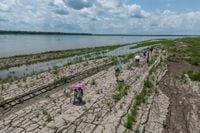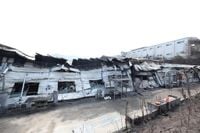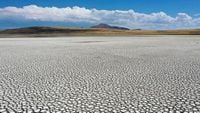Climate change has significantly impacted South Korea's wildfire risk, extending the period by as much as 120 days annually compared to preindustrial times, according to a study released by Greenpeace on March 31, 2025. The research, led by Professor Kim Hyung-jun from KAIST’s Moon Soul Graduate School of Future Strategy, utilized climate modeling to compare historical and current atmospheric conditions. The study applied five major simulation models from the Intergovernmental Panel on Climate Change’s Sixth Assessment Report to calculate average wildfire risk indices.
An index of 20 or higher indicates a high risk of wildfire, and the analysis revealed a troubling trend: the number of days nationwide with an index over 20 has risen significantly. In North Gyeongsang, particularly around the Sobaek Mountain Range, the risk period reached up to 151 days per year—more than ten times the 14 days recorded before industrialization.
“Human-induced climate change not only increases wildfire intensity but also causes risk periods to start earlier and end later,” Kim stated. This alarming finding highlights the need for urgent action as temperatures rise and dry conditions prevail.
Shim Hye-young, a senior researcher at Greenpeace, emphasized the dangers of Korea’s increasingly hot, dry climate, stating, “Short-term responses are not enough. We need a comprehensive wildfire strategy that addresses the climate crisis.” The researchers plan to continue their work, with projections of wildfire risk under future scenarios of global temperatures rising by 1.5 degrees Celsius (2.7 degrees Fahrenheit), 2 degrees, and 4 degrees expected to be published in the second half of 2025.
Furthermore, the study noted that wildfire risk has risen by more than 10 percent on average during peak fire seasons, which occur from March to April and October to November. The increase was particularly notable in inland areas of Chungcheong, Jeolla, and North Gyeongsang. Wildfire season has also shifted earlier by three to five weeks, with South Gyeongsang seeing the risk period move from late February to early February and South Jeolla from mid-April to early March. Similar changes were observed in North Chungcheong, Daejeon, and Daegu.
This alarming trend is not isolated to Korea. Around the globe, rising temperatures are increasing the odds of both severe drought and heavier precipitation. In 2023, California experienced record-setting rain and snowfall, leading to heavy vegetation growth that fueled devastating wildfires in January after drought conditions returned.
Experts explain that the relationship between climate change and extreme weather events is rooted in the water cycle. As global temperatures rise, the hydrological cycle speeds up, causing the atmosphere to hold 7% more water vapor for every degree Celsius increase. This leads to longer and more intense droughts, even as rain becomes less frequent but more intense when it does occur.
Jonathan Overpeck, a climate scientist at the University of Michigan, explained, “Basically, global warming is turning the atmosphere into a bigger sponge so it can soak up more moisture… and then when the conditions are right for rainfall, it’s like squeezing that sponge.” This phenomenon can lead to catastrophic flooding, as seen in Libya in 2023 when heavy rains overwhelmed dams, destroying entire neighborhoods.
Climate change is also affecting snowpack, a critical part of the hydrological cycle. Melting snow helps fill reservoirs and waterways, but less snow is falling overall, and what does fall is often absorbed by thirsty soil. Warmer winters mean that the growing season is longer, resulting in more snowmelt being lost through evapotranspiration of plants. Overpeck noted, “All this stuff is related to warming, which we know with perfect confidence is almost all due to human activity.”
In Utah, residents are grappling with similar challenges. Over the past few decades, the state has seen a significant rise in temperatures. Between 1970 and 2023, fall temperatures in Weber and Davis counties increased by 4.5°F, with nearly all counties experiencing at least a 3°F rise. Salt Lake City recorded its hottest October on record in 2024, averaging 66.2°F—almost 10 degrees above normal.
The prolonged heat has not only made summers uncomfortable but has also extended the forest fire season, increasing respiratory issues for outdoor enthusiasts. The Great Salt Lake, a defining feature of Utah’s ecosystem, has shrunk dramatically, covering approximately 2,300 square miles in 1986 but falling to a historic low elevation by July 2022. This environmental crisis poses a public health risk as the drying lakebed releases toxic dust into the air.
Since 1970, the demand for cooling in Salt Lake City schools has surged by 55%, forcing schools to invest more in air conditioning as students struggle to focus in overheated classrooms. As Utah grows, the strain on infrastructure becomes more apparent, affecting education, housing, energy, and transportation.
In response, young activists in Utah are taking action. In 2022, a group of youth filed a lawsuit against the state, arguing that its push for fossil fuel development violates their right to a healthy environment. This case illustrates a larger truth: the younger generation is demanding change and is unwilling to wait for politicians to take action.
As a resident of Utah, one young person reflected on their changing perspective: “When I first moved to Utah, I imagined it as my forever home. But climate change is forcing me to reconsider. Do I stay and fight for policies that will protect the environment I love, or do I eventually leave for a place with fewer climate risks?”
This sentiment echoes a broader call to action for Utah’s leaders to prioritize sustainable water management, renewable energy investments, and stricter environmental protections. It’s not just about politics; it’s about ensuring Utah remains a livable, thriving place for future generations.
As the impacts of climate change become more pronounced, the need for comprehensive strategies to address these challenges is urgent. The time to act is now.






